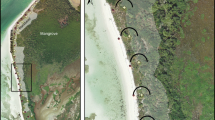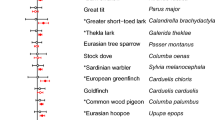Abstract
Interpreting data on distribution or population trends may be difficult unless detection probability is accounted for. We wished to determine the detectability of the rare and patchily distributed cobblestone tiger beetle (Cicindela marginipennis) along the upper Genesee River in western New York for development of a monitoring strategy. We used occupancy surveys and distance sampling to examine two types of detectability. The first type was site-level detectability: the probability of detecting a single cobblestone tiger beetle on an occupied cobble bar, calculated using program PRESENCE. The second type was individual-level detectability: the probability of detecting an individual cobblestone tiger beetle in a population on a single cobble bar, calculated using program DISTANCE. Our occupancy surveys consisted of collecting presence and absence data on cobble bars along the Genesee River; these showed a relatively narrow range of site-level detection probabilities (0.60–0.68) for cobblestone tiger beetles in 2008 and 2009. Three visits were necessary to detect cobblestone tiger beetles on 90% of occupied cobble bars. Individual cobblestone tiger beetles were detectable one-half of the time (0.50) in our surveys. It is important for ecologists to distinguish between the two kinds of detectability, as monitoring implications could differ substantially depending on which is calculated. Our monitoring recommendations include (1) continuing occupancy surveys with at least three visits to each cobble bar; (2) conducting occupancy surveys between 10:00 and 17:00 on warm sunny days in mid-July and mid-August; and (3) conducting surveys at three- to five-year intervals depending on the study objective.

Similar content being viewed by others
References
Bailey LL, Adams M (2005) Occupancy models to study wildlife. Available at http://fresc.usgs.gov/products/factsheets.aspx. Accessed 23 Mar 2008
Bailey LL, Simons TR, Pollock KH (2004) Estimating site occupancy and species detection probability parameters for terrestrial salamanders. Ecol App 14:692–702
Bailey LL, Hines JE, Nichols JD, MacKenzie DI (2007) Sampling design trade-offs in occupancy studies with imperfect detection: examples and software. Ecol App 17:281–290
Bates AJ, Sadler JP, Fowles AP (2007) Livestock trampling reduces the conservation value of beetle communities on high quality exposed riverine sediments. Biodiver Conser 16:1491–1509
Beavers SC, Ramsey FL (1998) Detectability analysis in transect surveys. J Wildl Manage 62:948–957
Bhargav V, Uniyay VP, Sivakumar K (2009) Distinctive patterns in habitat association and distribution of tiger beetles in the Shivalik landscape of North Western India. J Insect Conser 13:459–473
Brust ML, Hoback WW, Skinner KF, Knisley CB (2005) Differential immersion survival by populations of Cicindela hirticollis (Coleoptera: Cicindeliadae). Annu Entomol Soc Am 98:973–979
Buckland ST, Anderson DR, Burnham KP, Laake JL, Borchers DL, Thomas L (2001) Introduction to distance sampling. Oxford University Press, New York
Bulluck L, Fleishman E, Betrus C, Blair R (2006) Spatial and temporal variations in species occurrence rate affect the accuracy of occurrence models. Global Ecol Biogeog 15:27–38
Burnham K, Anderson D (2002) Model selection and multimodel inference: a practical information-theoretic approach. Springer, New York
Cornelisse TM, Hafernik JE (2009) Effects of soil characteristics and human disturbance on tiger beetle oviposition. Ecol Entom 34:495–503
de Solla SR, Shirose LJ, Fernie KJ, Barrett GC, Brousseau CS, Bishop CA (2005) Effect of sampling effort and species detectability on volunteer based anuran monitoring programs. Biol Conserv 121:585–594
Donovan TM, Hines J (2007) Exercises in occupancy estimation and modeling estimation. Available at http://www.uvm.edu/envnr/vtcfwru/spreadsheets/occupancy/occupancy.htm. Accessed 19 Sept 2009
Dunn GA, Wilson D (1979) Cicindela marginipennis in New Hampshire. Cicindela 11:49–56
Edwards TC, Cutler DR, Geiser L, Alegria J, McKenzie D (2004) Assessing rarity of species with low detectability: lichens in Pacific Northwest Forests. Ecol Appl 14:414–424
Field SA, Tyre AJ, Possingham HP (2005) Optimizing allocation of monitoring effort under economic and observational constraints. J Wildl Manage 69:473–482
Gjerdrum C, Elphick CS, Rubega M (2005) Nest site selection and nesting success in saltmarsh breeding sparrows: the importance of nest habitat, timing, and study site differences. Condor 107:849–862
Graves RC, Brzoska DW (1991) The tiger beetles of Ohio (Coleoptera: Cicindelidae). College of Biological Sciences. Ohio State University, Columbus
Gu W, Swihart RK (2004) Absent or undetected? Effects of non-detection of species occurrence on wildlife-habitat models. Biol Conser 116:195–203
Hagler JR, Jackson CG (2001) Methods for marking insects: current techniques and future prospects. Annu Rev Entom 46:511
Hines JE (2006) PRESENCE2- Software to estimate patch occupancy and related parameters. USGS-PWRC. Available at http://www.mbr-pwrc.usgs.gov/software/presence.html. Accessed 08 Feb 2010
Hoback WW, Golick DA, Svatos TM, Spomer SM, Higley LG (2000) Salinity and shade preferences result in ovipositional differences between sympatric tiger beetle species. Ecol Entomol 25:180–187
Hudgins RM (2010) Habitat selection, dispersal and detectability of cobblestone tiger beetles (Cicindela marginipennis Dejean) along the Genesee River. M.Sc. Thesis. New York State University of New York, College at Brockport, Brockport, New York
Hudgins RM, Norment C, Schlesinger MD, Novak PG (2011) Habitat selection, dispersal and detectability of cobblestone tiger beetles (Cicindela marginipennis Dejean) along the Genesee River, New York. Am Midl Nat 165:304–318
Joseph LN, Field SA, Wilcox C, Possing H (2006) Presence–absence versus abundance data for monitoring threatened species. Conser Biol 20:1679–1687
Knisley CB, Fenster MS (2005) Apparent extinction of the tiger beetle, Cicindela hirticollis abrupta (Coleoptera: Carabidae: Cicindelinae). Coleopts Bull 59:451–458
Lovett GM, Burns DA, Driscoll CT, Jenkins JC, Mitchell MJ, Rustad L, Shanley JB, Likens GE, Haeuber R (2007) Who needs environmental monitoring? Front Ecol Environ 5:253–260
MacKenzie DI (2005) What are the issues with presence-absence data for wildlife managers? J Wildl Manage 69:849–860
MacKenzie DI, Royle JA (2005) Designing occupancy studies: general advice and allocating survey effort. J Appl Ecol 42:1105–1114
MacKenzie DI, Nichols JD, Sutton N, Kawanishi K, Bailey LL (2005) Improving inferences in population studies of rare species that are detected imperfectly. Ecology 86:1101–1113
MacKenzie DI, Nichols JD, Pollock KH, Royle JA, Bailey LL, Hines JE (2006) Occupancy estimation and modeling: inferring patterns and dynamics of species occurrence. Academic Press, San Diego
Mawdsley JR (2007) Ecology, distribution, and conservation biology of the tiger beetle Cicindela patruela consentanea Dejean (Coleoptera: Carabidae: Cicindelinae). Proc Entomol Soc Wash 109:17–28
McCreadie JW, Adler PH (2008) Spatial distribution of rare species in lotic habitats. J Insect Conserv Diver 1:127–134
McDonald LL (2004) Sampling rare populations. In: Sampling rare or elusive species: concepts, designs, and techniques for estimating population parameters. Island Press, Washington DC, pp 11–42
Naiman RJ, Decamps H (1997) The ecology of interfaces: riparian zones. Annu Rev Ecol Syst 28:621–658
NatureServe (2009) NatureServe species profile for Cicindela marginipennis. NatureServe’s Central Databases. Arlington, VA. USA. Available at http://export.nbii.gov/xml/natureserv/html/Cicindelidae/0/ELEMENT_GLOBAL_2_109719.html. Accessed 07 Feb 2008
New York Natural Heritage Program (2010) Biotics database. New York Department of Environmental Conservation, Albany, New York
New York State Department of Environmental Conservation (ed) (2006) Comprehensive wildlife conservation strategy (CWCS) plan: NYS Department of Environmental Conservation. New York State Department of Environmental Conservation, Albany, New York. Available at http://www.dec.ny.gov/animals/30483.html. Accessed 18 Mar 2008
Nichols JD, Williams BK (2006) Monitoring for conservation. Trends Ecol Evol 21:668–673
Nothnagle P (1995) Survey of the White River for the cobblestone tiger beetle, Cicindela marginipennis. Nongame and Natural Heritage Program Vermont Fish and Wildlife Department, Waterbury, VT
Novak PG (2006) State wildlife comprehensive plan–draft species group report for riparian tiger beetles. In: New York State Department of Environmental Conservation (ed) Comprehensive Wildlife Conservation Strategy (CWCS) Plan: NYS Department of Environmental Conservation Appendix. New York State Department of Environmental Conservation, Albany, New York, pp 115–118
Pearson DL, Knisley CB, Kazilek CJ (2006) A field guide to the tiger beetles of the United States and Canada. Oxford University Press, New York, New York
Pearson DL, Anderson CD, Mitchell BR, Rosenberg MS, Navarrete R, Coopmans P (2009) Testing hypotheses of bird extinctions at Rio Palenque, Ecuador, with informal species lists. Conserv Biol 24:500–510
Primack RB (2006) Essentials of conservation biology, 4th edn. Sinauer Associates, Inc., Sunderland
Pyzikiewicz AJ (2005) New Hampshire Wildlife action plan profile. Available at http://www.wildlife.state.nh.us/Wildlife/Wildlife_Plan/WAP_species_PDFs/Invertibrates/Cobblestone%20Tiger%20Beetle.pdf. Accessed 16 Jan 2010
SaintOurs FH (2002) Fall 2002 conservation perspectives: drainage to dragonflies: conservation of aquatic invertebrates. Available at http://www.nescb.org/epublications/fall2002/saintours.html. Accessed 29 Nov 2009
Schlesinger MD, Novak PG (2011) Status and conservation of an imperiled tiger beetle fauna in New York State, USA. J Insect Conserv. doi:10.1007/s10841-011-9382-y
SPSS (2008) SPSS for Windows GradPack 17.0 release 17.0.0. SPSS, an IBM Company, Chicago. Available at http://www.spss.com. Accessed 07 Dec 2009
Thomas L, Buckland ST, Rexstad EA, Laake JL, Strindberg S, Hedley SL, Bishop JR, Marques TA, Burnham KP (2009) Distance software: design and analysis of distance sampling surveys for estimating population size. J Appl Ecol 47:5–14
Thompson WL (ed) (2004) Sampling rare or elusive species: concepts, designs, and techniques for estimating population parameters. Island Press, Washington, pp 429
U.S. Fish and Wildlife Service (2005) Furbish Lousewort Pedicularis fubishiae. Northeast Region U.S. Fish and Wildlife Service. Available at http://www.fws.gov/northeast/pdf/furbish.fs.pdf. Accessed 09 May 2010
Acknowledgments
Funding for this project was through New York State Wildlife Grant T-2-2 in cooperation with the U.S. Fish and Wildlife Service Division of Wildlife and Sport Fish Restoration and managed by the New York Natural Heritage Program. We would like to thank our field assistants, R. Stotz (2008) and C. Bruet (2009); Letchworth State Park employees, especially D. Bassett, for his knowledge and insight of the park’s ecology and R. Beck, Park Manager, for camping access; and NY Natural Heritage Program and NY DEC personnel, especially P. Novak and E. White. We would also like to thank T. N. Martin for his whole-hearted support.
Author information
Authors and Affiliations
Corresponding author
Rights and permissions
About this article
Cite this article
Hudgins, R.M., Norment, C. & Schlesinger, M.D. Assessing detectability for monitoring of rare species: a case study of the cobblestone tiger beetle (Cicindela marginipennis Dejean). J Insect Conserv 16, 447–455 (2012). https://doi.org/10.1007/s10841-011-9432-5
Received:
Accepted:
Published:
Issue Date:
DOI: https://doi.org/10.1007/s10841-011-9432-5




